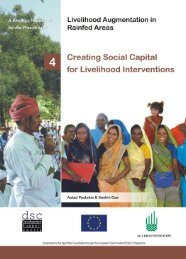Livelihood Augmentation in Rainfed Areas - Development Support ...
Livelihood Augmentation in Rainfed Areas - Development Support ...
Livelihood Augmentation in Rainfed Areas - Development Support ...
Create successful ePaper yourself
Turn your PDF publications into a flip-book with our unique Google optimized e-Paper software.
practitioners as well as academics will f<strong>in</strong>d this compilation a useful reference and<br />
guide for unlock<strong>in</strong>g the vast potential of ra<strong>in</strong>fed areas for food security and livelihood<br />
augmentation (LA).<br />
The handbook is presented <strong>in</strong> four parts <strong>in</strong> order to facilitate proper coverage and<br />
handl<strong>in</strong>g of key aspects of LA <strong>in</strong> ra<strong>in</strong>fed areas. These <strong>in</strong>troduction, which provides<br />
the context of ra<strong>in</strong>fed areas, is common to all the volumes.<br />
Emerg<strong>in</strong>g Crisis of Indian Agriculture<br />
Like most other develop<strong>in</strong>g economies, India began as an agrarian State. Even today<br />
agriculture is a source of livelihood for about 60 per cent of its population and provides<br />
employment to about 56 per cent of the country’s work force. However, the growth rate<br />
of agriculture steadily decl<strong>in</strong>ed from 3.2 per cent <strong>in</strong> the 80s to around 2 per cent <strong>in</strong><br />
the last 4-5 years. On the other hand, <strong>in</strong>dustrial growth has been buoyant at around 8<br />
per cent. Such skewed growth rates are a matter of serious concern for planners and<br />
policy makers of the country at the highest level.<br />
An analysis of spatial growth patterns <strong>in</strong> agriculture shows that the growth <strong>in</strong> the Green<br />
Revolution areas (Punjab, Haryana and western UP) has tapered off and <strong>in</strong> some<br />
places it is even show<strong>in</strong>g signs of decl<strong>in</strong>e (India Today, June, 2007). The ‘treadmill<br />
effect’ caused by high and imbalanced external <strong>in</strong>put farm<strong>in</strong>g, soil ‘fatigue’ and decl<strong>in</strong><strong>in</strong>g<br />
soil health, dependence on a narrow base of crop varieties lead<strong>in</strong>g to mono-culture,<br />
greater vulnerability to pests and depletion of groundwater resources are some of the<br />
better known reasons for stagnation and decl<strong>in</strong>e <strong>in</strong> yields <strong>in</strong> the Green Revolution<br />
areas. In addition, the cost of chemical <strong>in</strong>tensive farm<strong>in</strong>g has been ris<strong>in</strong>g progressively<br />
without a correspond<strong>in</strong>g <strong>in</strong>crease <strong>in</strong> the price of produce, mak<strong>in</strong>g farm<strong>in</strong>g less and<br />
less attractive as an economic activity. The grow<strong>in</strong>g rate of farmer suicides, which has<br />
crossed 20,000 per year, may be seen as one of the <strong>in</strong>dicators of the emerg<strong>in</strong>g crisis<br />
of Indian agriculture (ibid.).<br />
One way out of the crisis is to step up the <strong>in</strong>vestments <strong>in</strong> irrigation projects. However,<br />
public <strong>in</strong>vestment <strong>in</strong> irrigation has decl<strong>in</strong>ed from 23 per cent dur<strong>in</strong>g the First Plan period<br />
to about 5 per cent <strong>in</strong> the Tenth Plan (ibid.). Accord<strong>in</strong>g to the National Commission on<br />
Agriculture, even if the entire irrigation potential of the country is developed, more<br />
than 50 per cent of arable land will still rema<strong>in</strong> ra<strong>in</strong>fed. With productivity <strong>in</strong> the Green<br />
Revolution areas becom<strong>in</strong>g stagnant and the likelihood of expand<strong>in</strong>g irrigated areas<br />
<strong>in</strong> the short run be<strong>in</strong>g limited, it is unlikely that future growth will come from irrigated<br />
areas. Rationaliz<strong>in</strong>g the use of water resources and focus<strong>in</strong>g on water resource<br />
efficiency, encourag<strong>in</strong>g conjunctive use of chemical and organic fertilizers; promot<strong>in</strong>g<br />
<strong>in</strong>tegrated pest management and us<strong>in</strong>g chemical pesticides as a last resort measure;<br />
The Untapped Potential of Ra<strong>in</strong>fed <strong>Areas</strong><br />
3



